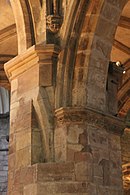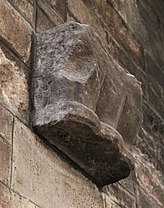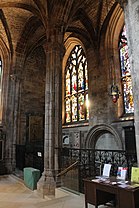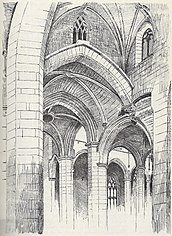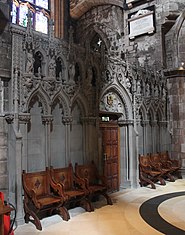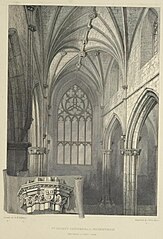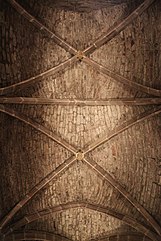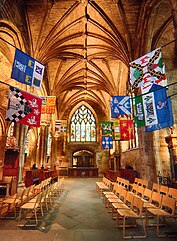
A | B | C | D | E | F | G | H | CH | I | J | K | L | M | N | O | P | Q | R | S | T | U | V | W | X | Y | Z | 0 | 1 | 2 | 3 | 4 | 5 | 6 | 7 | 8 | 9
| St Giles' Cathedral | |
|---|---|
| High Kirk of Edinburgh | |
Cathair-eaglais Naomh Giles | |
 West façade of the church building | |
 | |
| 55°56′58″N 03°11′27″W / 55.94944°N 3.19083°W | |
| Location | Royal Mile, Edinburgh |
| Country | Scotland |
| Denomination | Church of Scotland |
| Previous denomination | Roman Catholic |
| Website | www |
| History | |
| Status | Parish church |
| Founded | 12th century |
| Dedication | Saint Giles |
| Consecrated | 6 October 1243 |
| Past bishop(s) | Bishop of Edinburgh |
| Architecture | |
| Functional status | Active |
| Heritage designation | Category A listed building |
| Designated | 14 December 1970 |
| Style | Gothic |
| Specifications | |
| Length | 196 feet (60 metres) |
| Width | 125 feet (38 metres)[1] |
| Height | 52 feet (16 metres)[2] |
| Spire height | 145 feet (44 metres)[3] |
| Bells | 3 |
| Administration | |
| Presbytery | Edinburgh |
| Clergy | |
| Minister(s) | Vacant |
| Assistant | Sam Nwokoro |
| Laity | |
| Organist/Director of music | Michael Harris |
Listed Building – Category A | |
| Official name | High Street and Parliament Square, St Giles (High) Kirk |
| Designated | 14 December 1970 |
| Reference no. | LB27381 |
St Giles' Cathedral (Scottish Gaelic: Cathair-eaglais Naomh Giles), or the High Kirk of Edinburgh, is a parish church of the Church of Scotland in the Old Town of Edinburgh. The current building was begun in the 14th century and extended until the early 16th century; significant alterations were undertaken in the 19th and 20th centuries, including the addition of the Thistle Chapel.[4] St Giles' is closely associated with many events and figures in Scottish history, including John Knox, who served as the church's minister after the Scottish Reformation.[5]
Likely founded in the 12th century[6][7][8][a][b] and dedicated to Saint Giles, the church was elevated to collegiate status by Pope Paul II in 1467. In 1559, the church became Protestant with John Knox, the foremost figure of the Scottish Reformation, as its minister. After the Reformation, St Giles' was internally partitioned to serve multiple congregations as well as secular purposes, such as a prison and as a meeting place for the Parliament of Scotland. In 1633, Charles I made St Giles' the cathedral of the newly created Diocese of Edinburgh. Charles' attempt to impose doctrinal changes on the presbyterian Scottish Kirk, including a Prayer Book causing a riot in St Giles' on 23 July 1637, which precipitated the formation of the Covenanters and the beginnings of the Wars of the Three Kingdoms.[8] St Giles' role in the Scottish Reformation and the Covenanters' Rebellion has led to its being called "the Mother Church of World Presbyterianism".[12]
St Giles' is one of Scotland's most important medieval parish church buildings.[13] The first church of St Giles' was a small Romanesque building of which only fragments remain. In the 14th century, this was replaced by the current building which was enlarged between the late 14th and early 16th centuries. The church was altered between 1829 and 1833 by William Burn and restored between 1872 and 1883 by William Hay with the support of William Chambers. Chambers hoped to make St Giles' a "Westminster Abbey for Scotland" by enriching the church and adding memorials to notable Scots. Between 1909 and 1911, the Thistle Chapel, designed by Robert Lorimer, was added to the church.[4][14]
Since the medieval period, St Giles' has been the site of nationally important events and services; the services of the Order of the Thistle take place there. Alongside housing an active congregation, the church is one of Scotland's most popular visitor sites: it attracted over a million visitors in 2018.[15]
Name and dedication

Saint Giles is the patron saint of lepers. Though chiefly associated with the Abbey of Saint-Gilles in modern-day France, he was a popular saint in medieval Scotland.[16][17][c] The church was first possessed by the monks of the Order of St Lazarus, who ministered among lepers; if David I or Alexander I is the church's founder, the dedication may be connected to their sister Matilda, who founded St Giles in the Fields.[18]
Prior to the Reformation, St Giles' was the only parish church in Edinburgh[19] and some contemporary writers, such as Jean Froissart, refer simply to the "church of Edinburgh".[20] From its elevation to collegiate status in 1467 until the Reformation, the church's full title was "the Collegiate Church of St Giles of Edinburgh".[21] Even after the Reformation, the church is attested as "the college kirk of Sanct Geill".[22] The charter of 1633 raising St Giles' to a cathedral records its common name as "Saint Giles' Kirk".[23]
St Giles' held cathedral status between 1633 and 1638 and again between 1661 and 1689 during periods of episcopacy within the Church of Scotland.[19] Since 1689, the Church of Scotland, as a Presbyterian church, has had no bishops and, therefore, no cathedrals. St Giles' is one of a number of former cathedrals in the Church of Scotland – such as Glasgow Cathedral or Dunblane Cathedral – that retain their title despite having lost this status.[24] Since the church's initial elevation to cathedral status, the building as a whole has generally been called St Giles' Cathedral, St Giles' Kirk or Church, or simply St Giles'.[25]
The title "High Kirk" is briefly attested during the reign of James VI as referring to the whole building. A 1625 order of the Privy Council of Scotland refers to the Great Kirk congregation, which was then meeting in St Giles', as the "High Kirk". The title fell out of use until reapplied in the late 18th century to the East (or New) Kirk, the most prominent of the four congregations then meeting in the church.[26][27] Since 1883, the High Kirk congregation has occupied the entire building.[28]
Location
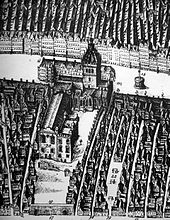
The Royal Commission on the Ancient and Historical Monuments of Scotland identified St Giles' as "the central focus of the Old Town".[29] The church occupies a prominent and flat portion of the ridge that leads down from Edinburgh Castle; it sits on the south side of the High Street: the main street of the Old Town and one of the streets that make up the Royal Mile.[9][30]
From its initial construction in the 12th century until the 14th century, St Giles' was located near the eastern edge of Edinburgh.[31][32] By the time of the construction of the King's Wall in the mid-15th century, the burgh had expanded and St Giles' stood near its central point.[33] In the late medieval and early modern periods, St Giles' was also located at the centre of Edinburgh's civic life: the Tolbooth – Edinburgh's administrative centre – stood immediately north-west of the church and the Mercat Cross – Edinburgh's commercial and symbolic centre – stood immediately north-east of it.[34]
From the construction of the Tolbooth in the late 14th century until the early 19th century, St Giles' stood in the most constricted point of the High Street with the Luckenbooths and Tolbooth jutting into the High Street immediately north and north-west of the church.[35] A lane known as the Stinkand Style (or Kirk Style) was formed in the narrow space between the Luckenbooths and the north side of the church.[36][37] In this lane, open stalls known as the Krames were set up between the buttresses of the church.[38]
St Giles' forms the north side of Parliament Square with the Law Courts on the south side of the square.[30] The area immediately south of the church was originally the kirkyard, which stretched downhill to the Cowgate.[39] For more than 450 years, St Giles' served as the parish burial ground for the whole of the burgh. At its greatest extent, the burial grounds covered almost 0.5ha.[40] This was closed to burials in 1561 and handed over to the town council in 1566. From the construction of Parliament House in 1639, the former kirkyard was developed and the square formed. The west front of St Giles' faces the former Midlothian County Buildings across West Parliament Square.[41]
History
Early years
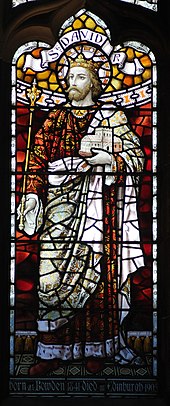
The foundation of St Giles' is usually dated to 1124 and attributed to David I. The parish was likely detached from the older parish of St Cuthbert's.[42][43] David raised Edinburgh to the status of a burgh and, during his reign, the church and its lands (St Giles' Grange) are first attested, being in the possession of monks of the Order of Saint Lazarus.[11][44] Remnants of the destroyed Romanesque church display similarities to the church at Dalmeny, which was built between 1140 and 1166.[19] St Giles' was consecrated by David de Bernham, Bishop of St Andrews on 6 October 1243. As St Giles' is attested almost a century earlier, this was likely a re-consecration to correct the loss of any record of the original consecration.[45]
In 1322 during the First Scottish War of Independence, troops of Edward II of England despoiled Holyrood Abbey and may have attacked St Giles' as well.[46] Jean Froissart records that, in 1384, Scottish knights and barons met secretly with French envoys in St Giles' and, against the wishes of Robert II, planned a raid into the northern counties of England.[47] Though the raid was a success, Richard II of England took retribution on the Scottish borders and Edinburgh in August 1385 and St Giles' was burned. The scorch marks were reportedly still visible on the pillars of the crossing in the 19th century.[48]
At some point in the 14th century, the 12th century Romanesque St Giles' was replaced by the current Gothic church. At least the crossing and nave had been built by 1387 as, in that year, Provost Andrew Yichtson and Adam Forrester of Nether Liberton commissioned John Skuyer, John Primrose, and John of Scone to add five chapels to the south side of the nave.[49][50]
In the 1370s, the Lazarite friars supported the King of England and St Giles' reverted to the Scottish crown.[48] In 1393, Robert III granted St Giles' to Scone Abbey in compensation for the expenses incurred by the abbey in 1390 during the King's coronation and the funeral of his father.[51][52] Subsequent records show clerical appointments at St Giles' were made by the monarch, suggesting the church reverted to the crown soon afterwards.[53]
Collegiate church
In 1419, Archibald Douglas, 4th Earl of Douglas led an unsuccessful petition to Pope Martin V to elevate St Giles' to collegiate status. Unsuccessful petitions to Rome followed in 1423 and 1429.[54] The burgh launched another petition for collegiate status in 1466, which was granted by Pope Paul II in February 1467.[55] The foundation replaced the role of vicar with a provost accompanied by a curate, sixteen canons, a beadle, a minister of the choir, and four choristers.[56]

During the period of these petitions, William Preston of Gorton had, with the permission of Charles VII of France, brought from France the arm bone of Saint Giles, an important relic. From the mid-1450s, the Preston Aisle was added to the southern side of the choir to commemorate this benefactor; Preston's eldest male descendants were given the right to carry the relic at the head of the Saint Giles' Day procession every 1 September.[57][58] Around 1460, extension of the chancel and the addition thereto of a clerestory were supported by Mary of Guelders, possibly in memory of her husband, James II.[59]
In the years following St Giles' elevation to collegiate status, the number of chaplainries and endowments increased greatly and by the Reformation there may have been as many as fifty altars in St Giles'.[60][61][d] In 1470, Pope Paul II further elevated St Giles' status by granting a petition from James III to exempt the church from the jurisdiction of the Bishop of St Andrews.[63]
During Gavin Douglas' provostship, St Giles' was central to Scotland's response to national disaster of the Battle of Flodden in 1513. As Edinburgh's men were ordered by the town council to defend the city, its women were ordered to gather in St Giles' to pray for James IV and his army.[64] Requiem Mass for the King and the memorial mass for the dead of the battle were held in St Giles' and Walter Chepman endowed a chapel of the Crucifixion in the lower part of the kirkyard in the King's memory.[65][66]
In the summer of 1544 during the war known as the Rough Wooing, after an English army had burnt Edinburgh, Regent Arran maintained a garrison of gunners in the tower of the church.[67]
The earliest record of Reformed sentiment at St Giles' is in 1535, when Andrew Johnston, one of the chaplains, was forced to leave Scotland on the grounds of heresy.[68] In October 1555, the town council ceremonially burned English language books, likely Reformers' texts, outside St Giles'.[69] The theft from the church of images of the Virgin, St Francis, and the Trinity in 1556 may have been agitation by reformers.[70] In July 1557, the church's statue of its patron, Saint Giles, was stolen and, according to John Knox, drowned in the Nor Loch then burned.[71] For use in that year's Saint Giles' Day procession, the statue was replaced by one borrowed from Edinburgh's Franciscans; though this was also damaged when Protestants disrupted the event.[72]
Reformation

At the beginning of 1559, with the Scottish Reformation gaining ground, the town council hired soldiers to defend St Giles' from the Reformers; the council also distributed the church's treasures among trusted townsmen for safekeeping.[73] At 3 pm on 29 June 1559 the army of the Lords of the Congregation entered Edinburgh unopposed and, that afternoon, John Knox, the foremost figure of the Reformation in Scotland, first preached in St Giles'.[74][75] The following week, Knox was elected minister of St Giles' and, the week after that, the purging of the church's Roman Catholic furnishings began.[76]
Mary of Guise (who was then ruling as regent for her daughter Mary) offered Holyrood Abbey as a place of worship for those who wished to remain in the Roman Catholic faith while St Giles' served Edinburgh's Protestants. Mary of Guise also offered the Lords of the Congregation that the parish church of Edinburgh would, after 10 January 1560, remain in whichever confession proved the most popular among the burgh's inhabitants.[77][78] These proposals, however, came to nothing and the Lords of the Congregation signed a truce with the Roman Catholic forces and vacated Edinburgh.[78] Knox, fearing for his life, left the city on 24 July 1559.[79] St Giles', however, remained in Protestant hands. Knox's deputy, John Willock, continued to preach even as French soldiers disrupted his sermons, and ladders, to be used in the Siege of Leith, were constructed in the church.[78][80]
The events of the Scottish Reformation thereafter briefly turned in favour of the Roman Catholic party: they retook Edinburgh and the French agent Nicolas de Pellevé, Bishop of Amiens, reconsecrated St Giles' as a Roman Catholic church on 9 November 1559.[78][81] After the Treaty of Berwick secured the intervention of Elizabeth I of England on the side of the Reformers, they retook Edinburgh. St Giles' once again became a Protestant church on 1 April 1560 and Knox returned to Edinburgh on 23 April 1560.[78][82] The Parliament of Scotland legislated that, from 24 August 1560, the Pope had no authority in Scotland.[83]
Workmen, assisted by sailors from the Port of Leith, took nine days to clear stone altars and monuments from the church. Precious items used in pre-Reformation worship were sold.[84] The church was whitewashed, its pillars painted green, and the Ten Commandments and Lord's Prayer painted on the walls.[85] Seating was installed for children and the burgh's council and incorporations. A pulpit was also installed, likely at the eastern side of the crossing.[86] In 1561, the kirkyard to the south of the church was closed and most subsequent burials were conducted at Greyfriars Kirkyard.[87]
Church and crown: 1567–1633
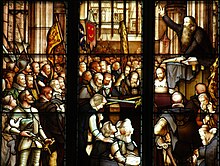
In 1567, Mary, Queen of Scots was deposed and succeeded by her infant son, James VI, St Giles' was a focal point of the ensuing Marian civil war. After his assassination in January 1570, the Regent Moray, a leading opponent of Mary, Queen of Scots, was interred within the church; John Knox preached at this event.[22] Edinburgh briefly fell to Mary's forces and, in June and July 1572, William Kirkcaldy of Grange stationed soldiers and cannon in the tower.[88] Although his colleague of 9 years John Craig had remained in Edinburgh during these events, Knox, his health failing, had retired to St Andrews. A deputation from Edinburgh recalled him to St Giles' and there he preached his final sermon on 9 November 1572.[89] Knox died later that month and was buried in the kirkyard in the presence of the Regent Morton.[90][91]
After the Reformation, parts of St Giles' were given over to secular purposes. In 1562 and 1563, the western three bays of the church were partitioned off by a wall to serve as an extension to the Tolbooth: it was used, in this capacity, as a meeting place for the burgh's criminal courts, the Court of Session, and the Parliament of Scotland.[92] Recalcitrant Roman Catholic clergy (and, later, inveterate sinners) were imprisoned in the room above the north door.[93] The tower was also used as a prison by the end of the 16th century.[94] The Maiden – an early form of guillotine – was stored in the church.[95] The vestry was converted into an office and library for the town clerk and weavers were permitted to set up their looms in the loft.[96]
Around 1581, the interior was partitioned into two meeting houses: the chancel became the East (or Little or New) Kirk and the crossing and the remainder of the nave became the Great (or Old) Kirk. These congregations, along with Trinity College Kirk and the Magdalen Chapel, were served by a joint kirk session. In 1598, the upper storey of the Tolbooth partition was converted into the West (or Tolbooth) Kirk.[97][98]
During the early majority of James VI, the ministers of St Giles' – led by Knox's successor, James Lawson – formed, in the words of Cameron Lees, "a kind of spiritual conclave with which the state had to reckon before any of its proposals regarding ecclesiastical matters could become law".[99] During his attendance at the Great Kirk, James was often harangued in the ministers' sermons and relations between the King and the Reformed clergy deteriorated.[100] In the face of opposition from St Giles' ministers, James introduced successive laws to establish episcopacy in the Church of Scotland from 1584.[101] Relations reached their nadir after a tumult at St Giles' on 17 December 1596. The King briefly removed to Linlithgow and the ministers were blamed for inciting the crowd; they fled the city rather than comply with their summons to appear before the King.[102] To weaken the ministers, James made effective, as of April 1598, an order of the town council from 1584 to divide Edinburgh into distinct parishes.[103] In 1620, the Upper Tolbooth congregation vacated St Giles' for the newly established Greyfriars Kirk.[104][105]
Cathedral
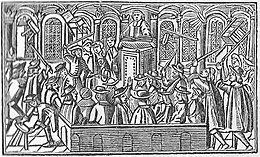
James' son and successor, Charles I, first visited St Giles' on 23 June 1633 during his visit to Scotland for his coronation. He arrived at the church unannounced and displaced the reader with clergy who conducted the service according to the rites of the Church of England.[106] On 29 September that year, Charles, responding to a petition from John Spottiswoode, Archbishop of St Andrews, elevated St Giles' to the status of a cathedral to serve as the seat of the new Bishop of Edinburgh.[23][107] Work began to remove the internal partition walls and to furnish the interior in the manner of Durham Cathedral.[108]
Work on the church was incomplete when, on 23 July 1637, the replacement in St Giles' of Knox's Book of Common Order by a Scottish version of the Church of England's Book of Common Prayer provoked rioting due to the latter's perceived similarities to Roman Catholic ritual. Tradition attests that this riot was started when a market trader named Jenny Geddes threw her stool at the dean, James Hannay.[109][110] In response to the unrest, services at St Giles' were temporarily suspended.[111]

The events of 23 July 1637 led to the signing of the National Covenant in February 1638, which, in turn, led to the Bishops' Wars, the first conflict of the Wars of the Three Kingdoms.[112] St Giles' again became a Presbyterian church and the partitions were restored.[113] Before 1643, the Preston Aisle was also fitted out as a permanent meeting place for the General Assembly of the Church of Scotland.[114]
In autumn 1641, Charles I attended Presbyterian services in the East Kirk under the supervision of its minister, Alexander Henderson, a leading Covenanter. The King had lost the Bishops' Wars and had come to Edinburgh because the Treaty of Ripon compelled him to ratify Acts of the Parliament of Scotland passed during the ascendancy of the Covenanters.[115]
After the Covenanters' loss at the Battle of Dunbar, troops of the Commonwealth of England under Oliver Cromwell entered Edinburgh and occupied the East Kirk as a garrison church.[116] General John Lambert and Cromwell himself were among English soldiers who preached in the church and, during the Protectorate, the East Kirk and Tolbooth Kirk were each partitioned in two.[117][118]
At the Restoration in 1660, the Cromwellian partition was removed from the East Kirk and a new royal loft was installed there.[119] In 1661, the Parliament of Scotland, under Charles II, restored episcopacy and St Giles' became a cathedral again.[120] At Charles' orders, the body of James Graham, 1st Marquess of Montrose – a senior supporter of Charles I executed by the Covenanters – was re-interred in St Giles'.[121] The reintroduction of bishops sparked a new period of rebellion and, in the wake of the Battle of Rullion Green in 1666, Covenanters were imprisoned in the former priests' prison above the north door, which, by then, had become known as "Haddo's Hole" due to the imprisonment there in 1644 of Royalist leader Sir John Gordon, 1st Baronet, of Haddo.[122]
After the Glorious Revolution, the Scottish bishops remained loyal to James VII.[123] On the advice of William Carstares, who later became minister of the High Kirk, William II supported the abolition of bishops in the Church of Scotland and, in 1689, the Parliament of Scotland restored Presbyterian polity.[124][125][126] In response, many ministers and congregants left the Church of Scotland, effectively establishing the independent Scottish Episcopal Church.[127] In Edinburgh alone, eleven meeting houses of this secession sprang up, including the congregation that became Old St Paul's, which was founded when Alexander Rose, the last Bishop of Edinburgh in the established church, led much of his congregation out of St Giles'.[128][129][130]
Four churches in one: 1689–1843
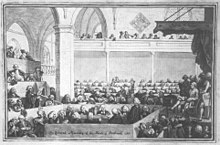
In 1699, the courtroom in the northern half of the Tolbooth partition was converted into the New North (or Haddo's Hole) Kirk.[131] At the Union of Scotland and England's Parliaments in 1707, the tune "Why Should I Be Sad on my Wedding Day?" rang out from St Giles' recently installed carillon.[132] During the Jacobite rising of 1745, inhabitants of Edinburgh met in St Giles' and agreed to surrender the city to the advancing army of Charles Edward Stuart.[133]
From 1758 to 1800, Hugh Blair, a leading figure of the Scottish Enlightenment and religious moderate, served as minister of the High Kirk; his sermons were famous throughout Britain and attracted Robert Burns and Samuel Johnson to the church. Blair's contemporary, Alexander Webster, was a leading evangelical who, from his pulpit in the Tolbooth Kirk, expounded strict Calvinist doctrine.[134][135]
At the beginning of the 19th century, the Luckenbooths and Tolbooth, which had enclosed the north side of the church, were demolished along with shops built up around the walls of the church.[136] The exposure of the church's exterior revealed its walls were leaning outwards.[26] In 1817, the city council commissioned Archibald Elliot to produce plans for the church's restoration. Elliot's drastic plans proved controversial and, due to a lack of funds, nothing was done with them.[137][138]

George IV attended service in the High Kirk during his 1822 visit to Scotland.[139] The publicity of the King's visit created impetus to restore the now-dilapidated building.[140] With £20,000 supplied by the city council and the government, William Burn was commissioned to lead the restoration.[141][142] Burn's initial plans were modest, but, under pressure from the authorities, Burn produced something closer to Elliot's plans.[137][143]
Between 1829 and 1833, Burn significantly altered the church: he encased the exterior in ashlar, raised the church's roofline and reduced its footprint. He also added north and west doors and moved the internal partitions to create a church in the nave, a church in the choir, and a meeting place for the General Assembly of the Church of Scotland in the southern portion. Between these, the crossing and north transept formed a large vestibule. Burn also removed internal monuments; the General Assembly's meeting place in the Preston Aisle; and the police office and fire engine house, the building's last secular spaces.[144][145][137]
Burn's contemporaries were split between those who congratulated him on creating a cleaner, more stable building and those who regretted what had been lost or altered.[146][147] In the Victorian era and the first half of the 20th century, Burn's work fell far from favour among commentators.[148][149] Its critics included Robert Louis Stevenson, who stated: "…zealous magistrates and a misguided architect have shorn the design of manhood and left it poor, naked, and pitifully pretentious."[150] Since the second half of the 20th century, Burn's work has been recognised as having secured the church from possible collapse.[151][152][153]
The High Kirk returned to the choir in 1831. The Tolbooth Kirk returned to the nave in 1832; when they left for a new church on Castlehill in 1843, the nave was occupied by the Haddo's Hole congregation. The General Assembly found its new meeting hall inadequate and met there only once, in 1834; the Old Kirk congregation moved into the space.[154][155]
Victorian era

At the Disruption of 1843, Robert Gordon and James Buchanan, ministers of the High Kirk, left their charges and the established church to join the newly founded Free Church.[e] A significant number of their congregation left with them; as did William King Tweedie, minister of the first charge of the Tolbooth Kirk,[f] and Charles John Brown, minister of Haddo's Hole Kirk.[146][158][159] The Old Kirk congregation was suppressed in 1860.[160][g]
At a public meeting in Edinburgh City Chambers on 1 November 1867, William Chambers, publisher and Lord Provost of Edinburgh, first advanced his ambition to remove the internal partitions and restore St Giles' as a "Westminster Abbey for Scotland".[163] Chambers commissioned Robert Morham to produce initial plans.[137] Lindsay Mackersy, solicitor and session clerk of the High Kirk, supported Chambers' work and William Hay was engaged as architect; a management board to supervise the design of new windows and monuments was also created.[164][165]
The restoration was part of a movement for liturgical beautification in late 19th century Scottish Presbyterianism and many evangelicals feared the restored St Giles' would more resemble a Roman Catholic church than a Presbyterian one.[166][167] Nevertheless, the Presbytery of Edinburgh approved plans in March 1870 and the High Kirk was restored between June 1872 and March 1873: the pews and gallery were replaced with stalls and chairs and, for the first time since the Reformation, stained glass and an organ were introduced.[137][168]
The restoration of the former Old Kirk and the West Kirk began in January 1879. In 1881, the West Kirk vacated St. Giles'.[169] During the restoration, many human remains were unearthed; these were transported in five large boxes for reinterment in Greyfriars Kirkyard.[170] Although he had managed to view the reunified interior, William Chambers died on 20 May 1883, only three days before John Hamilton-Gordon, 7th Earl of Aberdeen, Lord High Commissioner to the General Assembly of the Church of Scotland, ceremonially opened the restored church; Chambers' funeral was held in the church two days after its reopening.[137][171]
20th and 21st centuries

In 1911, George V opened the newly constructed chapel of the knights of the Order of the Thistle at the south east corner of the church.[172]
Though the church had hosted a special service for the Church League for Women's Suffrage, Wallace Williamson’s refusal to pray for imprisoned suffragettes led to their supporters disrupting services during late 1913 and early 1914.[173]
Ninety-nine members of the congregation – including the assistant minister, Matthew Marshall – were killed in World War I.[173] In 1917, St Giles' hosted the lying-in-state and funeral of Elsie Inglis, medical pioneer and member of the congregation.[174][175]
Ahead of the 1929 reunion of the United Free Church of Scotland and the Church of Scotland, the Church of Scotland (Property and Endowments) Act 1925 transferred ownership of St Giles' from the City of Edinburgh Council to the Church of Scotland.[176][177]
The church escaped World War II undamaged. The week after VE Day, the royal family attended a thanksgiving service in St Giles'. The Albany Aisle at the north west of the church was subsequently adapted to serve as a memorial chapel to the 39 members of the congregation killed in the conflict.[178]
To mark her first visit to Scotland since her coronation, Elizabeth II received the Honours of Scotland at a national service of thanksgiving in St Giles' on 24 June 1953.[179]
From 1973 to 2013, Gilleasbuig Macmillan served as minister of St Giles'.[180] During Macmillan's incumbency, the church was restored and the interior reoriented around a central communion table, the interior floor was levelled and undercroft space was created by Bernard Feilden.[137][181]
St Giles' remains an active parish church as well as hosting concerts, special services, and events.[182] In 2018, St Giles' was the fourth most popular visitor site in Scotland with over 1.3 million visitors that year.[15]
On 12 September 2022, the coffin of the late Queen Elizabeth II was taken to the cathedral for a service of thanksgiving, having travelled from Balmoral Castle to the Palace of Holyroodhouse the previous day.[183][184] The Queen's coffin then lay at rest at the cathedral for 24 hours, guarded constantly by the Royal Company of Archers, allowing the people of Scotland to pay their respects. In the evening, the Queen's children; King Charles III, the Princess Royal, the Earl of Inverness and the Earl of Forfar held a vigil at the cathedral, a custom known as the Vigil of the Princes.[185]
On 5 July 2023, the Honours of Scotland were presented to King Charles III in a ceremony held in St Giles' Cathedral. The ceremony was formally described as a National Service of Thanksgiving and Dedication to mark the coronation of King Charles III and Queen Camilla.[186]
Architecture
"No other Scottish church has so tangled an architectural history."[13]
Ian Hannah, The Story of Scotland in Stone (1934)
The first St Giles' was likely a small, Romanesque building of the 12th century with a rectangular nave and semi-circular apsidal chancel. Before the middle of the 13th century, an aisle was added to the south of the church.[18] Archaeological excavations in the 1980s found the 12th-century church was likely constructed of pink sandstone and grey whinstone.[40] The excavations, found the first church was built on a substantial clay platform created to level the steep slope of the area. This platform was surrounded by a boundary ditch.[40]
By 1385, this building had likely been replaced by the core of the current church: a nave and aisles of five bays, a crossing and transepts, and a choir of four bays.[187] The church was extended in stages between 1387 and 1518.[19][188] In Richard Fawcett's words, this "almost haphazard addition of large numbers of chapels" produced "an extraordinarily complex plan".[189] The resultant profusion of outer aisles is typical of French medieval church architecture but unusual in Britain.[190][191]
Apart from the internal partitioning of the church in the wake of the Reformation, few significant alterations were made until the restoration by William Burn in 1829–1833, which included the removal of several bays of the church, the addition of clerestories to the nave and transepts, and the encasement of the church's exterior in polished ashlar.[137] The church was significantly restored under William Hay between 1872 and 1883, including the removal of the last internal partitions. In the late 19th century, a number of ground level rooms were added around the periphery of the church. The Thistle Chapel was added to the south-east corner of the church by Robert Lorimer in 1909–11.[137][153] The most significant subsequent restoration commenced in 1979 under Bernard Feilden and Simpson & Brown: this included the levelling of the floor and the rearrangement of the interior around a central communion table.[137][192]
Exterior
The exterior of the church, with the exception of the tower, dates almost entirely from William Burn's restoration of 1829–1833 and afterwards.[137][193] Prior to this restoration, St Giles' possessed what Richard Fawcett called a "uniquely complex external appearance" as the result of the church's numerous extensions; externally, a number of chapels were emphasised by gables.[194]
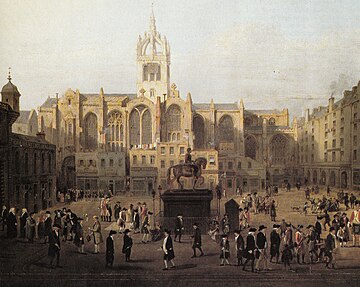
Following the early 19th-century demolition of the Luckenbooths, Tolbooth, and shops built against St Giles', the walls of the church were exposed to be leaning outward by as much as one and a half feet in places. Burn encased the exterior of the building in polished ashlar of gray sandstone from Cullalo in Fife. This layer is tied to the existing walls by iron cramps and varies in width from eight inches (20 centimetres) at the base of the walls to five inches (12.5 centimetres) at the top.[193] Burn co-operated with Robert Reid, the architect of new buildings in Parliament Square, to ensure the exteriors of their buildings would complement each other.[195] Burn significantly altered the profile of the church: he expanded the transepts, created a clerestory in the nave, added new doorways in the west front and north and south transepts, and replicated the cusped cresting from the east end of the church throughout the parapet.[137] Alongside the Thistle Chapel, extensions since the Burn restoration include William Hay's additions of 1883: rooms south of the Moray Aisle, east of the south transept, and west of the north transept; in 1891, MacGibbon and Ross added a ladies’ vestry – now the shop – at the east of the north transept.[196][197]
Burn created a symmetrical western façade by replacing the west window of the Albany Aisle at the northwest corner of the church with a double niche and by moving the west window of the inner south nave aisle to repeat this arrangement in the southern half.[198] The west doorway dates from the Victorian restoration and is by William Hay: the doorway is flanked by niches containing small statues of Scottish monarchs and their consorts (from left to right, Alexander I, David I, Alexander III, Saint Margaret, Margaret Tudor, Robert the Bruce, James I and James IV) and churchmen (from left to right, Gawin Douglas, John Knox, William Forbes and Alexander Henderson) by John Rhind, who also carved the relief of Saint Giles in the tympanum.[199] The metalwork of the west door is by Skidmore.[200] In 2006, new steps and an access ramp were added to the west door by Morris and Steedman Associates.[201]
In order to improve access to Parliament Square, Burn demolished the westernmost two bays of the outer south nave aisle, including the south porch and door. Burn also removed the western bay from the Holy Blood Aisle at the south of the church and, from the north side of the nave, removed the north porch along with an adjoining bay.[202][203] The lost porches likely dated from the late-15th century and were matched only by those at St John's Kirk, Perth and St Michael's Kirk, Linlithgow as the grandest two-storey porches on Scottish medieval churches. Like the porch at Linlithgow, on which they were likely based, the porches at St Giles' possessed an entry arch below an oriel window.[204] Burn replicated this arrangement in a new doorway at the west of the Moray Aisle.[198]
On visiting the church prior to the Burn restoration, Thomas Rickman wrote: "... a few of the windows have the tracery remaining, but from most of them it has been cut away."[205] Views of the church before the Burn restoration show intersecting tracery in some of the choir windows and looping patterns in the windows of the Holy Blood Aisle.[206] Burn retained the tracery of the great east window, which had been restored by John Mylne the Younger in the mid-17th century. In the other windows Burn inserted new tracery based on late medieval Scottish examples.[198][207]
Tower and crown steeple

St Giles' possesses a central tower over its crossing: this arrangement is common in larger Scottish medieval secular churches.[208][209] The tower was constructed in two stages. The lower section of the tower has lancet openings with Y-shaped tracery on every side.[210] This had likely been completed by 1416, in which year the Scotichronicon records storks nesting there.[211] The upper stage of the tower has clusters of three cusped lancet openings on each side. The date of this work is uncertain, but it may relate both to fines levied on building works at St Giles' in 1486 and to rules of 1491 for the master mason and his men.[210][212] From at least 1590, there was a clock face on the tower and, by 1655, there were three faces. The clock faces were removed in 1911.[213]
St Giles' crown steeple is one of Edinburgh's most famous and distinctive landmarks.[210][214][215] Cameron Lees wrote of the steeple: "Edinburgh would not be Edinburgh without it."[216] Dendrochronological analysis dates the crown steeple to between 1460 and 1467.[217][h] The steeple is one of two surviving medieval crown steeples in Scotland: the other is at King's College, Aberdeen and dates from after 1505.[220] John Hume called St Giles' crown steeple "a serene reminder of the imperial aspirations of the late Stewart monarchs".[221] The design, however, is English in origin, being found at St Nicholas' Church, Newcastle before it was introduced to Scotland at St Giles'; the medieval St Mary-le-Bow, London, may also have possessed a crown steeple.[210][222][223] Another crown steeple existed at St Michael's Parish Church, Linlithgow until 1821 and others may have been planned, and possibly begun, at the parish churches of Haddington and Dundee.[224] These other examples are composed only of diagonal flying buttresses springing from the four corners of the tower; whereas the St Giles' steeple is unique among medieval crown steeples in being composed of eight buttresses: four springing from the corners and four springing from the centre of each side of the tower.[225][226][227]
For the arrival into Edinburgh of Anne of Denmark in 1590, 21 weather vanes were added to the crests of the steeple; these were removed prior to 1800 and replacements were installed in 2005.[226][228] The steeple was repaired by John Mylne the Younger in 1648. Mylne added pinnacles half-way up the crests of the buttresses; he is also largely responsible for the present appearance of the central pinnacle and may have rebuilt the tower's traceried parapet.[226][229] The weathercock atop the central pinnacle was created by Alexander Anderson in 1667; it replaced an earlier weathercock of 1567 by Alexander Honeyman.[230]
The Buildings of Scotland series calls the nave "archaeologically the most complicated part of church".[231] Though the nave dates to the 14th century and is one of the oldest parts of the church, it has been significantly altered and extended since.[232]
The ceiling over the central section of the nave is a tierceron vault in plaster; this was added during William Burn's restoration of 1829–1833. Burn also heightened the walls of the central section of the nave by 16 feet (4.8 metres), adding windows to create a clerestory.[218] Burn is usually credited with removing a medieval vaulted ceiling from the nave; however, there is no contemporary record of this and it may have been removed before Burn's time.[233] The corbels and shafts leading to the springers of the vaults were added by William Hay in 1882.[231] Burn also removed an attic from above the central section of the nave: this contained several rooms and housed the church's bell-ringer.[95][234] The outline of the nave roof prior to the Burn restoration can be observed on the wall above the western arch of the crossing.[235]
Hay is also responsible for the present arcade.[231] Burn had earlier heightened the medieval arcade and replaced the octagonal 14th century pillars with pillars based on the 15th century example in the Albany Aisle. Hay replaced these pillars with replicas of the octagonal 14th century pillars of the choir.[231][218] Originally, the south arcade of the nave was lower with a clerestory window above each arch. The lower height of the original arcade is indicated by a fragment of an arch, springing from the south west pier of the crossing.[218] The arches of the clerestory windows, now filled-in, are still visible above the each arch of the arcade on the south side of the nave.[231] The two arches nearest the crossing at the south nave arcade show taller arches, which likely relate to a medieval scheme to heighten the arcade; however, the presence of these blind arches in only two bays suggests the scheme proved abortive.[231][218]
The ceiling of the north nave aisle is a rib vault in a similar style to the Albany Aisle: this suggests the north nave aisle dates to the same campaign of building at the turn of the 15th century.[236][237][238]
In the first decade of the 15th century, the Albany Aisle was erected as a northward extension of the two westernmost bays of the north nave aisle.[19][193] The Aisle consists of two bays under a stone rib-vaulted ceiling.[239][240] The west window of the chapel was blocked up during the Burn restoration of 1829–1833.[238] The north wall of the Aisle contains a semi-circular tomb recess.[236][238] The ceiling vaults are supported by a bundled pillar that supports a foliate capital and octagonal abacus upon which are the escutcheons of the Aisle's donors: Robert Stewart, Duke of Albany and Archibald Douglas, 4th Earl of Douglas.[236][237] This is the oldest example of a style of pillar repeated throughout the later additions to St Giles'.[241][242] Richard Fawcett describes the repetition of this style of pillar and arcading as providing "some measure of control to achieve a measure of architectural unity".[189] Neither Albany nor Douglas was closely associated with St Giles' and tradition holds the aisle was donated in penance for their involvement in the death of David Stewart, Duke of Rothesay.[237][243][244][245] In 1882, the floor of the Albany Aisle was paved with Minton tiles, bands of Irish marble, and tiled medallions depicting the arms of Scotland; Robert Stewart, Duke of Albany; and Archibald Douglas, 4th Earl of Douglas.[246] For the Aisle's dedication as a memorial chapel in the wake of the Second World War, the Minton tiles were replaced with Leoch paving stones from Dundee while the heraldic medallions and marble bands were retained.[247]
East of the Albany Aisle, two light-coloured stones below the Black Watch's Egyptian Campaign memorial mark the site of the Norman north door. Until its removal at the end of the 18th century, the doorway was the only feature of the 12th century Romanesque church in situ.[19][193][i] An illustration of 1799 shows the doorway as a highly decorated structure, bearing similarities to doorways at the churches of Dalmeny and Leuchars.[19][249] A porch stood over the site of the north door until the Burn restoration of 1829–1833. This consisted of a chamber over the doorway accessed from the church by a turnpike stair.[238][250] The lancet arch of the stairway door now frames the Second Battalion Royal Scots Fusiliers' Second Boer War memorial. East of the former doorway is a recessed stoup.[236][238][251]
Two chapels formerly stood north of the easternmost two bays of the north nave aisle. Only the easternmost of these, the St Eloi Aisle, survived the Burn restoration.[252] Its ceiling is a barrel vault with superficial ribs: this was installed during William Hay's restoration of 1881–83 and incorporates a boss from the original vault. The archway between the St Eloi Aisle and the north nave aisle is original to the 15th century construction.[236] The west wall of the St Eloi Aisle contains a Romanesque capital from the original church. It was discovered during the clearance of rubble around the medieval east window of the north transept in 1880 and was reset in its present position.[193][236][253] The floor of the St Eloi Aisle is marble with mosaic panels by Minton, depicting the emblem the Incorporation of Hammermen between the symbols of the four evangelists.[254]

The inner and outer south nave aisles were likely begun in the later 15th century around the time of the Preston Aisle, which they strongly resemble.[236] They were likely completed by 1510, when altars of the Holy Trinity, Saint Apollonia, and Saint Thomas were added to the west end of the inner aisle.[236] The current aisles replaced the original south nave aisle and the five chapels by John Primrose, John Skuyer, and John of Perth, named in a contract of 1387.[236] The inner aisle retains its original quadripartite vault; however, the plaster tierceron vault of the outer aisle (known as the Moray Aisle) dates to William Burn's restoration.[236][238] During the Burn restoration, the two westernmost bays of the outer aisle were removed. There remains a prominent gap between the pillars of the missing bays and the 19th century wall. At the west end of the outer aisle, Burn added a new wall with a door and oriel window.[238] Burn also replaced the window of the inner aisle with a smaller window, centred north of the original in order to accommodate a double niche on the exterior wall. The outline of the original window is still visible in the interior wall.[236]
In 1513, Alexander Lauder of Blyth commissioned an aisle of two bays at the eastern end of the outer south nave aisle: the Holy Blood Aisle is the easternmost and only surviving bay of this aisle.[1] It is named for the Confraternity of the Holy Blood, to whom it was granted upon completion in 1518.[255] The western bay of the Aisle and the pillar separating the two bays were removed during the Burn restoration and the remainder was converted to a heating chamber.[256] The Aisle was restored to ecclesiastical use under William Hay.[236] An elaborate late Gothic tomb recess occupies the south wall of the aisle.[236][238]
Crossing and transepts
The piers of the crossing date to the original building campaign of the 14th century and may be the oldest part of the present church.[19] The piers were likely raised around 1400, at which time the present vault and bell hole were created.[238][257] The first stages of both transepts were likely completed by 1395, in which year the St John's Aisle was added to the north of the north transept.[19]
Initially, the north transept extended no further than the north wall of the aisles and possessed a tunnel-vaulted ceiling at the same height as those in the crossing and aisles. The arches between the transept and north aisles of the choir and nave appear to be 14th century.[238][258] The St John's Chapel, extending north of the line of the aisles, was added in 1395; in its western end was a turnpike stair, which, at the Burn restoration, was re-set in the thick wall between the St Eloi Aisle and the north transept.[19][238][253][258] The remains of St John's Chapel are visible in the east wall of the north transept: these include fragments of vaulting and a medieval window, which faces into the Chambers Aisle. The bottom half of this window's tracery, as far as its embattled transom, is original; curvilinear tracery was added to the upper half by MacGibbon and Ross in 1889–91.[238][253][258] At the Burn restoration, the north transept was heightened and a clerestory and plaster vaulted ceiling inserted.[238][258] A screen of 1881-83 by William Hay crosses the transept in line with the original north wall, creating a vestibule for the north door. The screen contains sculptures of the patron saints of the Incorporated Trades of Edinburgh by John Rhind as well as the arms of William Chambers.[258][259] The ceiling and open screens within the vestibule were designed by Esmé Gordon and added in 1940.[258] A fragment of medieval blind tracery is visible at the western end of this screen.[258]
Initially, the south transept only extended to the line of the south aisles; it was extended in stages as the Preston, Chepman, and Holy Blood Aisles were added.[231] The original barrel vault remains as far as an awkwardly inserted transverse arch supported on heavy corbels between the inner transept arches: this arch was likely inserted after the creation of the Preston Aisle, when the inner transept arches were expanded accordingly.[231][238] The transverse arch carries an extension to the lower part of the tower, including a 15th-century traceried window.[260] The south transept was heightened and a clerestory and plaster vaulted ceiling were inserted during the Burn restoration.[231]
Choir
The Buildings of Scotland series calls the choir the "finest piece of late medieval parish church architecture in Scotland".[226] The choir dates to two periods of building: one in the 14th century and one in the 15th.[261] The archaeological excavations indicate the choir was extended to almost its current size in a single phase before the mid-15th-century work.[40]
The choir was initially built as a hall church: as such, it was unique in Scotland.[226] The western three bays of the choir date to this initial period of construction. The arcades of these bays are supported by simple, octagonal pillars.[226] In the middle of the 15th century, two bays were added to the east end of the choir and the central section was raised to create a clerestory under a tierceron-vaulted ceiling in stone.[262] The springers of the original vault are still visible above some of the capitals of the choir pillars and the outline of the original roof is visible above the eastern arch of the crossing.[235] A grotesque at the intersection of the central rib of the ceiling and the east wall of the tower may be a fragment of the 12th century church.[44] The two pillars and two demi-pillars constructed during this expansion in the easternmost bays of the choir are similar in type to those in the Albany Aisle.[262]
Of the two pillars added during this extension, the northern one is known as the "King's Pillar" as its capital bears the arms of James III on its east face; James II on its west face; Mary of Guelders on its north face; and France on its south face.[263][264] These arms date the work between the birth of James II in 1453 and the death of Mary of Guelders in 1463; the incomplete tressure in the arms of James II may indicate he was dead when the work commenced, dating it to after 1460.[265] The southern pillar is known as the "Town's Pillar".[264] Its capital bears the arms of William Preston of Gorton on its east face; James Kennedy, Bishop of St Andrews on its west face; Nicholas Otterbourne, Vicar of Edinburgh on its north face; and Edinburgh on its south face. The south respond bears the arms of Thomas Cranstoun, Chief Magistrate of Edinburgh; the north respond bears the arms of Alexander Napier of Merchiston, Provost of Edinburgh.[266] Archaeological excavations in the 1980s found evidence these works and the creation of the Preston Aisle may have been partially spurred by a structural failure of parts of the church due to poor foundations and the need for renovations.[40]
Choir aisles
Of the two choir aisles, the north is only two thirds the width of the south aisle, which contained the Lady Chapel prior to the Reformation.[226][219] Richard Fawcett suggests this indicates that both choir aisles were rebuilt after 1385.[219] In both aisles, the curvature of the spandrels between the ribs gives the effect of a dome in each bay.[234][243][267] The ribs appear to serve a structural purpose; however, the lack of any intersection between the lateral and longitudinal cells of each bay means that these vaults are effectively pointed barrel vaults.[13][268] Having been added as part of the mid-15th century extension, the eastern bays of both aisles contain proper lateral cells.[262] The north wall of the north choir aisle contains a 15th-century tomb recess; in this wall, a grotesque, which may date to the 12th century church, has been re-set.[44][262] At the east end of the south aisle is a stone staircase added by Bernard Feilden and Simpson & Brown in 1981–82.[262]
The Chambers Aisle stands north of the westernmost bay of the north choir aisle. This chapel was created in 1889–91 by MacGibbon and Ross as a memorial to William Chambers.[262] This Aisle stands on the site of the medieval vestry, which, at the Reformation, was converted to the Town Clerk's office before being restored to its original use by William Burn.[269] MacGibbon and Ross removed the wall between the vestry and the church and inserted a new arch and vaulted ceiling, both of which incorporate medieval masonry.[262][270]
The Preston Aisle stands south of the western three bays of the south choir aisle. It is named for William Preston of Gorton, who donated Saint Giles' arm-bone to the church; Preston's arms recur in the bosses and capitals of the chapel.[253][271] The town council began the Aisle's construction in 1455, undertaking to complete it within seven years; however, the presence in the Aisle of a boss bearing the arms of Lord Hailes, Provost of Edinburgh in the 1480s, suggests construction took significantly longer.[262] The Aisle's tierceron vault and pillars are similar to those in the 15th century extension of the choir.[253][258] The pillars and capitals also bear a strong resemblance to those between the inner and outer south nave aisles.[272]
The Chepman Aisle extends south of the westernmost bay of the Preston Aisle. The Aisle was founded by Walter Chepman; permission for construction was granted in 1507 and consecration took place in 1513.[258] The ceiling of the Aisle is a pointed barrel vault whose central boss depicts an angel bearing Chepman's arms impaled with those of his first wife, Mariota Kerkettill.[258][272] The Aisle was divided into three storeys during the Burn restoration then restored in 1888 under the direction of Robert Rowand Anderson.[273]
Stained glass
St Giles' is glazed with 19th and 20th century stained glass by a diverse array of artists and manufacturers. Between 2001 and 2005, the church's stained glass was restored by the Stained Glass Design Partnership of Kilmaurs.[274]
Fragments of the medieval stained glass were discovered in the 1980s: none was obviously pictorial and some may have been grisaille.[61] A pre-Reformation window depicting an elephant and the emblem of the Incorporation of Hammermen survived in the St Eloi Aisle until the 19th century.[275] References to the removal of the stained glass windows after the Reformation are unclear.[85][276] A scheme of coloured glass was considered as early as 1830: three decades before the first new coloured glass in a Church of Scotland building was installed at Greyfriars Kirk in 1857; however, the plan was rejected by the town council.[203][277]
Victorian windows

By the 1860s, attitudes to stained glass had liberalised within Scottish Presbyterianism and the insertion of new windows was a key component of William Chambers' plan to restore St Giles'.[163] The firm of James Ballantine was commissioned to produce a sequence depicting the life of Christ, as suggested by the artists Robert Herdman and Joseph Noel Paton. This sequence commences with a window of 1874 in the north choir aisle and climaxes in the great east window of 1877, depicting the Crucifixion and Ascension.[278][279]
Other windows by Ballantine & Son are the Prodigal Son window in the south wall of the south nave aisle; the west window of the Albany Aisle, depicting the parable of the Wise and Foolish Virgins and the parable of the talents (1876); and the west window of the Preston Aisle, depicting Saint Paul (1881).[280] Ballantine & Son are also responsible for the window of the Holy Blood Aisle, depicting the assassination and funeral of the Regent Moray (1881): this is the only window of the church that depicts events from Scottish history.[281][282][283] Andrew Ballantine produced the west window in the south wall of the inner south nave aisle (1886): this depicts scenes from the life of Moses.[281] The subsequent generation of the Ballantine firm, Ballantine & Gardiner, produced windows depicting the first Pentecost (1895) and Saint Peter (1895–1900) in the Preston Aisle; David and Jonathan in the east window of the south side of the outer south nave aisle (1900–01); Joseph in the east window of the south wall of the inner south nave aisle (1898); and, in the windows of the Chambers Aisle, Solomon's construction of the Temple (1892) and scenes from the life of John the Baptist (1894).[280][270]
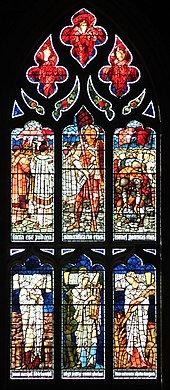
Multiple generations of the Ballantine firm executed heraldic windows in the oriel window of the outer south nave aisle (1883) and in the clerestory of the choir (1877–92): the latter series depicts the arms of the Incorporated Trades of Edinburgh. David Small is responsible for the easternmost window of the north side of the clerestory (1879).[280] Ballantine & Son also produced the window of the Chepman Aisle, showing the arms of notable 17th century Royalists (1888); in the St Eloi Aisle, the Glass Stainers' Company produced a companion window, showing the arms of notable Covenanters (1895).[281][284]
Daniel Cottier designed the east window of the north side of the north nave aisle, depicting the Christian virtues (1890). Cottier also designed the great west window, now-replaced, depicting the Prophets (1886).[281][285][286] Edward Burne-Jones designed the window in the west wall of the north nave aisle (1886). This was produced by Morris & Co. and shows Joshua and the Israelites in the upper section with Jephthah's daughter, Miriam, and Ruth in the lower section.[281][285][286] Other stained glass artists of the Victorian era represented in St Giles' are Burlison & Grylls, who executed the Patriarchs window in the west wall of the inner south nave aisle and Charles Eamer Kempe, who created the west window of the south side of the outer south nave aisle: this depicts biblical writers.[281]
20th century windowsedit

Oscar Paterson is responsible for the west window of the north side of the north nave aisle (1906): this shows saints associated with St Giles'.[281] Karl Parsons designed the west window of the south side of the south choir aisle (1913): this depicts saints associated with Scotland.[279] Douglas Strachan is responsible for the windows of the choir clerestory that depict saints (1932–35) and for the north transept window (1922): this shows Christ walking on water and stilling the Sea of Galilee, alongside golden angels subduing demons that represent the four winds of the earth.[174][281][287]
Windows of the later 20th century include a window in the north transept clerestory by William Wilson, depicting Saint Andrew (1954), and the east window of the Albany Aisle, on the theme of John the Divine, designed by Francis Spear and painted by Arthur Pearce (1957).[281][288][289] The most significant recent window is the great west window, a memorial to Robert Burns (1985). This was designed by Leifur Breiðfjörð to replace the Cottier window of 1886, the glass of which had failed.[281][290][291] A scheme of coloured glass, designed by Christian Shaw, was installed in the south transept behind the organ in 1991.[289]
Memorialsedit
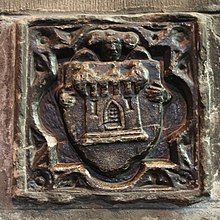
There are over a hundred memorials in St. Giles'; most date from the 19th century onwards.[292]
In the medieval period, the floor of St Giles' was paved with memorial stones and brasses; these were gradually cleared after the Reformation.[293] At the Burn restoration of 1829–1833, most post-Reformation memorials were destroyed; fragments were removed to Culter Mains and Swanston.[294]
The installation of memorials to notable Scots was an important component of William Chambers' plans to make St Giles' the "Westminster Abbey of Scotland".[293][163] To this end, a management board was set up in 1880 to supervise the installation of new monuments; it continued in this function until 2000.[295] All the memorials were conserved between 2008 and 2009.[296]
Ancient memorialsedit

Medieval tomb recesses survive in the Preston Aisle, Holy Blood Aisle, Albany Aisle, and north choir aisle; alongside these, fragments of memorial stones have been re-incorporated into the east wall of the Preston Aisle: these include a memorial to "Johannes Touris de Innerleith" and a carving of the coat of arms of Edinburgh.[294]
A memorial brass to the Regent Moray is situated on his monument in the Holy Blood Aisle. The plaque depicts female personifications of Justice and Religion flanking the Regent's arms and an inscription by George Buchanan. The plaque was inscribed by James Gray on the rear of a fragment of a late 15th century memorial brass: a fibreglass replica of this side of the brass is installed on the opposite wall.[294][297] The plaque was originally set in a monument of 1570 by Murdoch Walker and John Ryotell: this was destroyed at the Burn restoration but the plaque was saved and reinstated in 1864, when John Stuart, 12th Earl of Moray commissioned David Cousin to design a replica of his ancestor's memorial.[279][297]
A memorial tablet in the basement vestry commemorates John Stewart, 4th Earl of Atholl, who was buried in the Chepman Aisle in 1579.[294] A plaque commemorating the Napiers of Merchiston is located on the north exterior wall of the choir.[210] This was likely installed on the south side of the church by Archibald Napier, 1st Lord Napier in 1637; it was moved to its present location during the Burn restoration.[225][294]
Victorian and Edwardian memorialsedit
Most memorials installed between the Burn restoration of 1829–1833 and the Chambers restoration of 1872–83 are now located in the north transept: these include white marble tablets commemorating Major General Robert Henry Dick (died 1846); Patrick Robertson, Lord Robertson (died 1855); and Aglionby Ross Carson (1856).[298][299] The largest of these memorials is a massive plaque surmounted by an urn designed by David Bryce to commemorate George Lorimer, Dean of Guild and hero of the 1865 Theatre Royal fire (1867).[298][300]


William Chambers, who funded the restoration of 1872–83, commissioned the memorial plaque to Walter Chepman in the Chepman Aisle (1879): this was designed by William Hay and produced by Francis Skidmore.[279][301] Chambers himself is commemorated by a large plaque in a red marble frame (1894): located in the Chambers Aisle, this was designed by David MacGibbon with the bronze plaque produced by Hamilton and Inches.[302] William Hay, the architect who oversaw the restoration (died 1888), is commemorated by a plaque in the north transept vestibule with a relief portrait by John Rhind.[298][303]
The first memorial installed after the Chambers restoration was a brass plaque dedicated to Dean James Hannay, the cleric whose reading of Charles I's Scottish Prayer Book in 1637 sparked rioting (1882).[284][304] In response, and John Stuart Blackie and Robert Halliday Gunning supported a monument to Jenny Geddes, who, according to tradition, threw a stool at Hannay. An 1885 plaque on the floor between south nave aisles now marks the putative spot of Geddes' action.[284][305] Other historical figures commemorated by plaques of this period include Agnes Keith, Countess of Moray (1893); Robert Leighton (1883); Gavin Douglas (1883); Alexander Henderson (1883); William Carstares (1884); and John Craig (1883), and James Dalrymple, 1st Viscount Stair (1906).[306]

The largest memorials of this period are the Jacobean-style monuments to James Graham, 1st Marquess of Montrose in the Chepman Aisle (1888) and to his rival, Archibald Campbell, 1st Marquess of Argyll, in the St Eloi Aisle (1895); both are executed in alabaster and marble and take the form of aedicules in which lie life-size effigies of their dedicatees. The Montrose monument was designed by Robert Rowand Anderson and carved by John and William Birnie Rhind. The Argyll monument, funded by Robert Halliday Gunning, was designed by Sydney Mitchell and carved by Charles McBride.[307][308]
Other prominent memorials of this period include the Jacobean-style plaque on the south wall of the south choir aisle, commemorating John Inglis, Lord Glencorse and designed by Robert Rowand Anderson (1892); the memorial to Arthur Penrhyn Stanley (died 1881) in the Preston Aisle, including a relief portrait by Mary Grant; and the large bronze relief of Robert Louis Stevenson by Augustus Saint-Gaudens on the west wall of the Moray Aisle (1904).[307] A life-size bronze statue of John Knox by James Pittendrigh MacGillivray (1906) stands in the north nave aisle. This initially stood in a Gothic niche in the east wall of the Albany Aisle; the niche was removed in 1951 and between 1965 and 1983, the statue stood outside the church, in Parliament Square.[309]
Zdroj:https://en.wikipedia.org?pojem=St_Giles'_CathedralText je dostupný za podmienok Creative Commons Attribution/Share-Alike License 3.0 Unported; prípadne za ďalších podmienok. Podrobnejšie informácie nájdete na stránke Podmienky použitia.
Antropológia
Aplikované vedy
Bibliometria
Dejiny vedy
Encyklopédie
Filozofia vedy
Forenzné vedy
Humanitné vedy
Knižničná veda
Kryogenika
Kryptológia
Kulturológia
Literárna veda
Medzidisciplinárne oblasti
Metódy kvantitatívnej analýzy
Metavedy
Metodika
Text je dostupný za podmienok Creative
Commons Attribution/Share-Alike License 3.0 Unported; prípadne za ďalších
podmienok.
Podrobnejšie informácie nájdete na stránke Podmienky
použitia.
www.astronomia.sk | www.biologia.sk | www.botanika.sk | www.dejiny.sk | www.economy.sk | www.elektrotechnika.sk | www.estetika.sk | www.farmakologia.sk | www.filozofia.sk | Fyzika | www.futurologia.sk | www.genetika.sk | www.chemia.sk | www.lingvistika.sk | www.politologia.sk | www.psychologia.sk | www.sexuologia.sk | www.sociologia.sk | www.veda.sk I www.zoologia.sk







